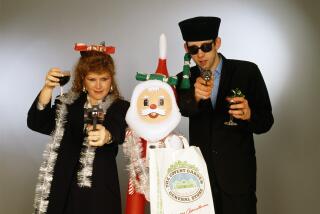Professor Sings Praises of Hymns : Music: The Pepperdine University academic has researched hundreds of religious works.
- Share via
Jerry Rushford is the hymn trivia king.
In nearly 30 years of research, the Pepperdine University religion professor has cultivated an unending repertoire of little-known facts about hymns--songs that praise God.
“I’m not musically talented at all,” said Rushford, 51, who estimates that he has researched 500 to 600 hymns. “I’m just fascinated by the origins of these hymns.”
From the stores of Rushford’s hymn trivia collection: The tune to “Silent Night” was written in five minutes in 1818 in the little town of Oberndorf, Austria, by the church music minister and was sung for the first time the same year. But the hymn would never have reached its status as the world’s most popular Christmas hymn if it were not for an organ repairman who overheard the sacred song and hummed it back to his own village.
The tune to “Hark the Herald Angels Sing” was written to commemorate the 400th anniversary of the Gutenberg printing press. Felix Mendelssohn, who wrote the song in 1840, considered it too secular and spirited for sacred music, Rushford said. It was not until 1855 that an American married the tune to the words, written as a poem by Charles Wesley in the 1700s. Wesley never heard his words sung as they are today.
Rushford’s hobby began in college, when he happened upon a magazine containing a collection of hymn stories.
“I was so surprised by it,” he said. “I knew God didn’t say, ‘Let there be hymns,’ but I didn’t realize there were stories behind them.”
For the last 10 years, Rushford has done most of his research during summer trips to England, where he visits the homes and churches where hymns were written and first performed. He has collected nearly 800 slides of hymn writers’ churches, graves and homes.
“The fact that I’m an American from Malibu always gets me invited for tea or dinner,” he said, adding that he gathers much of his information from villagers, who for generations have passed down tales about hymn origins.
Some of Rushford’s most memorable experiences in his hymn travels include climbing into the cleft of the rock where “Rock of Ages” was written, and visiting the home of John Newton, who wrote “Amazing Grace.” The room was still furnished with Newton’s easy chair and desk, and his Scriptures hung on the walls.
“I feel the spirit of place,” Rushford said. “It is spiritual for me to go to the place where something famous was written or first sung.”
Germans wrote the most hymns and the English--Rushford’s specialty--come in second, he said. No well-known hymns have been written for centuries, he added. The hymns that are well known today generally began as poems, and were later put to music.
“Joy to the World”--words by Isaac Watts and music by Handel--wasn’t put together until 1836, long after the author and composer had died.
Handel wrote his famed “Messiah” toward the end of his life, during the summer of 1741. He produced 260 pages of manuscript in 24 days.
“That would be like writing a Ph.D. dissertation in 24 days,” Rushford said.
*
According to some accounts, after Handel finished his work he was “bathed in tears and emotionally overcome,” Rushford said, and told a servant “I did think, I did see, the very face of God himself.”
The manuscript was auctioned off 95 years later for 1 pound.
Rushford still has a seemingly endless supply of hymns left to research, and said he has no plans to stop his investigations.
“I find it fascinating to find out about the people who wrote the words I’ve sung in church all my life since I was a little boy.”
More to Read
Sign up for Essential California
The most important California stories and recommendations in your inbox every morning.
You may occasionally receive promotional content from the Los Angeles Times.













